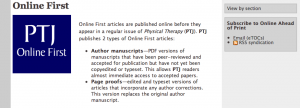This is the 5th in a series of posts investigating how to leverage technology:
In the previous blog posts I have outlined how information is pushed directly to you via RSS feeds and Web 2.0. I explained how to access information from journals and blogs without searching the net. I even discussed which journals and blogs you may want to follow and why. But, to truly engage, retain, critique, and apply this information to our clinical practices and research we must move beyond just reading. We need to discuss and analyze and integrate….but…
How do we do this when we are sitting by ourselves on a computer? There are a variety of built in tools that we can utilize to accomplish this within Google Reader, in the comments sections of blogs, via Twitter and Facebook. Most of the technology presented in this post series can be linked and utilized simultaneously. All of this from you office, laptop, tablet, or smart phone. In this post, I have bolded words, phrases, or concepts that I think are important throughout this post. This includes the concept of “pushing” information, modifying a tweet, micro-blogging, and discussion via blog comments.
The exact topic of blogs and the discussions stemming from them was recently written about on the CasesBlog: Medical and Health Blog. In the post, Blogging is good for you – and for most people who read blogs it is stated:
The back-and-forth between bloggers resembles the informal chats, in university hallways and coffee rooms, that have always stimulated economic research, argues Paul Krugman, a Nobel-prize winning economist who blogs at the New York Times. But moving the conversation online means that far more people can take part.
The post links to an article from the Economist Website titled Economic Blogs: A less dismal debate. Interestingly, they assert that papers that are blogged about and/or authors who blog may be considered more respected:
Academic papers cited by bloggers are far more likely to be downloaded. Blogging economists are regarded more highly than non-bloggers with the same publishing record.
I wonder if in the future, features such as track back or blog presence will be utilized to calculate a journal’s impact factor or rate researchers and academics.
TWITTER, with it’s 140 character limit for tweets and profile descriptions, is truly a micro-blogging medium. Everyone who is on Twitter is a micro-blogger. It forces succinct communication. Twitter offers a variety of opportunities and ways to access and discuss information. Obviously, you can read the tweets and go to the links that others post. You can reply to tweets to initiate a dialogue. RE-TWEET is when you tweet someone else’s tweet with RT before their twitter handle (name).

Now, you can also tweet a MODIFIED TWEET (MT). Essentially, with an MT you are changing or editing the content or message of a tweet. Below is an original tweet about manual therapy from @DenverDPT regarding manual therapy effects from the 2011 AAOMPT Annual Conference:


I then modified the phrasing and content to deliver a similar, but more specific message based on my understanding of manual therapy. I preceded the tweet with MT to communicate that I had modified an original tweet by Denver Lancaster.
I view FACEBOOK as a personal mini-blog. Links, videos, and articles can be posted with ease. Similar to a blog, friends can comment and discuss. Through pages, individuals can connect on a specific topic, cause, or organization. For example, the American Academy of Orthopaedic Manual Physical Therapists has a Facebook Page: AAOMPT Facebook Page. Beyond networking and professional connection, Facebook is an also a means to access, read, and talk about information.
It is not necessary to have your own BLOG to utilize the medium to discuss and learn. You can utilize BLOG COMMENTS to write your insights and questions. If you disagree with a conclusion you can formulate a more thorough, researched response. Often, I find myself more intrigued and challenged by the discussion that happens in the comments section of a blog post. Especially if you do not publish your own blog, posting well researched and thoughtful comments is essentially blogging! You can have online discussion with links to other blogs, research articles, and online resources with the blog’s author and commentors. Professionals, researchers, and students from across the world can have in-depth, passionate debates at their convenience. Want to stay plugged into a debate? Many blogs offer the option to SUBSCRIBE TO COMMENTS via e-mail or RSS. You will automatically be alerted when a new comment is posted.
After dabbling in blog engagement, you may even desire to publish your own blog. This process is actually quite simple. There are many free resources including Blogger and WordPress. Blogger is Google’s free blog hosting service. A very professional looking blog can be started in an afternoon utilizing free templates and helpful layout designs. As I have mentioned previously, I am disappointed in the lack of blogs surrounding neurologic and acute care physical therapist practice. I remain hopeful that this segment will grow.
PUSHING is an interesting concept in the current social media landscape. All of us has experienced pushing whether we realize it or not. E-mail is a pushing service. Information is pushed to our in-box, and we push information to others. As discussed in previous posts, we utilize Google Reader to have information pushed directly to one location (our RSS Reader). Further, information chosen specifically by our Facebook friends and the tweeps we follow on Twitter is pushed automatically to our news feeds. Conversely, we can push information between our social media accounts through certain applications or linkages. For example, I have a twitter application that allows me to push any tweet to my Facebook account by putting the hashtag (#) FB at the end of my tweet > #fb.
Some pushing and linking features are automatically available. You can “like” an item on Google Reader and then make comments. Then, individuals who follow you on Google Reader can see your comments. Information can be pushed or shared directly from Google Reader to Facebook and Twitter (via the “Send To” button). A post can also be made directly to Google+. There is even a button to e-mail the link!
 Most journals are now publishing content and articles online before the print version of the journal is available. E-PUB AHEAD OF PRINT simply means that article was electronically published online ahead of the print version. Journals, including Physical Therapy Journal, even have RSS feeds for E-Pub content. Now, people can blog, comment, Tweet, and Facebook about articles before the print version is published. By the time someone who subscribes to a print journal reads an article, it has probably arlready been shared, critiqued, analyzed, and discussed for weeks to MONTHS.
Most journals are now publishing content and articles online before the print version of the journal is available. E-PUB AHEAD OF PRINT simply means that article was electronically published online ahead of the print version. Journals, including Physical Therapy Journal, even have RSS feeds for E-Pub content. Now, people can blog, comment, Tweet, and Facebook about articles before the print version is published. By the time someone who subscribes to a print journal reads an article, it has probably arlready been shared, critiqued, analyzed, and discussed for weeks to MONTHS.
Interestingly, as widgets and applications evolve the line between various forms of social media and Web2.0 principles becomes more blurred. For example, Twitter feeds and tweets can be seamlessly integrated on the sidebar of a blog. Applications allow for the automatic pushing of tweets to Facebook profiles. And with tools such as HootSuite you can control both from one dashboard. Many Twitter applications allow the scheduling of Tweets into the future, so you do not overload followers with 1,249 tweets in 5.9 seconds. Facebook also allows users to create a badge, or snapshot, to have the sidebar of blogs.
Imagine networks of students, researchers, and clinicians connecting through Google Reader, Twitter, Facebook, and blogs to diseminate and discuss research, blog posts, newspaper articles, and legislation. Imagine the proliferation of professional networking, learning, and discussion. The potential exists for clinicians to collaborate remotely on patient care and research projects. If you have not already, check out PHYSIOPEDIA. Physio-pedia is the model for the future fusion of technology with education, learning, and research.
All of these tools have the ability to elevate our individual knowledge base, care delivery, and research. On a grand scale, it gives us the opportunity to improve professional growth and patient care for all regardless of geographical location. I imagine technology integration and colloboration as the basis for the future of “continuing education” and professional learning…
I envision a future where professionals from across the globe are accessing, disseminating, discussing, critiquing, and even performing research and clinical practice.
In the next post, I will illustrate these principles from a real life scenario. As a preview, I responded to a Tweet that linked to a performance and injury risk reduction program aimed at decreasing ACL injury rate AND improving performance. In that interaction, I utilized and pushed an article via Google Reader to Twitter. I was able to engage in a virtual conversation with a handful of individuals regarding the topic. After I present the interaction, I will discuss and analyze the encounter and research evidence surrounding the specific topic of ACL injury risk reduction and performance improvement.



Kyle,
Great post. Its pretty amazing how far we’ve come technologically; we are actually globalizing medical practice. Physicians are even using twitter during surgical procedures to educate thd masses. I think, especially in our field, where we are struggling to find consistency with procedures and terminology, the technology that you have mentioned here will help validate physical therapy in the medical community.
Yeah, it is very interesting. I think some of the tools at our disposable know could revolutionize how we educate, train, and administer care. I think it could really change the cont ed dinosaur.
Kyle, any way to put together a Google Reader collection with the RSS feeds for all of these fabulous blogs? One shot subscription!